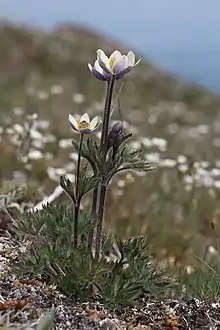Anemone multifida
Anemone multifida is a species of flowering plant in the buttercup family known by the common names cutleaf anemone,[1] Pacific anemone and globe anemone. It is a perennial herb native to northern North America from Alaska to New York and as far south as Arizona and New Mexico. It is also known from parts of South America.
| Anemone multifida | |
|---|---|
 | |
| Scientific classification | |
| Kingdom: | Plantae |
| Clade: | Tracheophytes |
| Clade: | Angiosperms |
| Clade: | Eudicots |
| Order: | Ranunculales |
| Family: | Ranunculaceae |
| Genus: | Anemone |
| Species: | A. multifida |
| Binomial name | |
| Anemone multifida | |
Description
This is a perennial herb which is quite variable in appearance, especially across varieties. It grows from a branching caudex to heights from 10 to 70 centimeters. The long petioled leaves are covered in a coat of long silky or coarse white hairs. Each leaf is divided into many long, pointed lobes, and the lobes are sometimes subdivided. Including the petiole a single leaf may be 5 to 20 centimeters long. The basal leaves are divided two or three times into narrow segments. The inflorescence holds one or more flowers. The flowers have no petals but four to eight (usually five) petallike sepals which may be nearly any color but typically white. They are somewhat hairy, especially on the outer surface. The center of the flower contains up to 80 stamens. The fruit is an achene that is woolly with long hairs, beaked, and a few millimeters long.[2]
Varieties
There are several varieties of this species:
Distribution and habitat
Anemone multifida is found growing on calcareous ledges, in areas with rocky or gravelly soils around lakes and other water ways, and on dunes.[2] In Minnesota it is record as growing in a prairie.[2]
It is typically found growing in subarctic and boreal areas in western and central North America but some populations are also found in mountainous and temperate habitats in the southern parts of its North American range. It is also found around the Great lakes region and there are rare occurrences in the north eastern US states and eastern Canada.[2]
A. multifada is poisonous as it has high ranunculin content: about 8.1% in aerial parts and 4% in root per dry weight.[3]
References
- "Anemone multifida". Germplasm Resources Information Network. Agricultural Research Service, United States Department of Agriculture. Retrieved 21 January 2018.
- Barbara Coffin; Lee Pfannmuller (1988). Minnesota's Endangered Flora and Fauna. U of Minnesota Press. p. 50. ISBN 978-0-8166-1689-3.
- Bai, Yili; Benn, Michael H.; Majak, Walter; McDiarmid, Ruth (1996). "Extraction and HPLC Determination of Ranunculin in Species of the Buttercup Family". Journal of Agricultural and Food Chemistry. 44 (8): 2235–2238. doi:10.1021/jf950626m. ISSN 0021-8561.